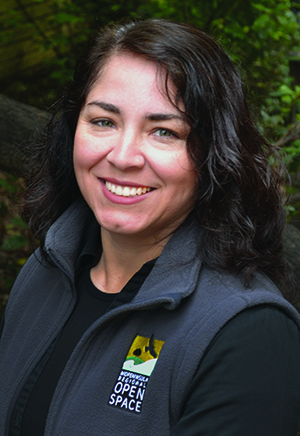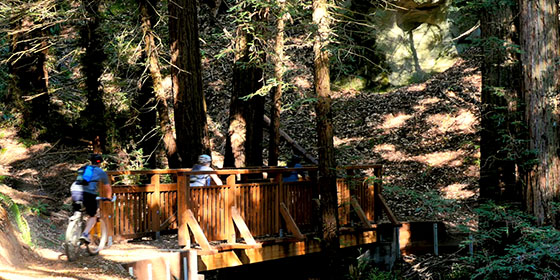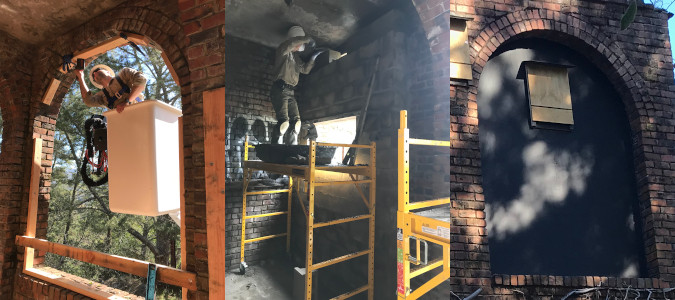A new trail connection, building a bat cave, working in a changing landscape and more in our fall newsletter.
There are three ways to enjoy the quarterly newsletter: flip through the online version, scroll below to read, or download a pdf.
New Oljon Trail Connection: A Watershed Moment
Passing through mixed redwood and tanoak forest, the new 1.3-mile section of the Oljon Trail promises to be a delight for mountain bikers, hikers and equestrians alike at El Corte de Madera Creek Preserve. The Oljon Trail is named to honor the indigenous tribe that inhabited this area of the Santa Cruz Mountains.
The Oljon Trail addition connects to the Spring Board Trail and allows visitors to enjoy new loop routes without having to use Skyline Boulevard/CA 35 or Bear Gulch Road, making the experience safer. As part of this project, the steep eastern portion of the Steam Donkey Trail that connected to Skyline Boulevard has been removed and restored to natural habitat.
The Measure AA–funded Oljon Trail project is the last piece of an 18-year El Corte de Madera Creek watershed protection program designed to protect sensitive fish habitat, improve overall watershed health and enhance the trail experience for visitors.
This comprehensive watershed protection program was developed in coordination with the National Marine Fisheries Service, California Department of Fish and Wildlife and the Regional Water Quality Control Board.
After more than a century of historic activities and human impacts resulting in significant erosion, restoration work was critical to bring the watershed back to health. The Spanish phrase “el corte de madera” roughly translates to “the wood cut,” referring to the clear-cut logging that took place here, starting in the 1860s. The property was logged as recently as 1988, and was also used as a motorcycle park when Midpen purchased the property.
The watershed protection program removed overly steep trails, replaced culverts with bridges, added drainage features, made road improvements to reduce sediment from flowing into the streams, and returned old roads to a more natural state. “Undertaking technically challenging projects like this allows Midpen’s crew of expert trail builders to further refine their craft and pass knowledge down to the next generation,” said Capital Projects Field Manager Bryan Apple.
Midpen Natural Resources scientists are in the midst of a multiyear sediment study to measure the watershed protection program’s benefits.
Learn more about the watershed protection program
Building a Bat “Cave” at Bear Creek Redwoods
When we acquired the newly opened Bear Creek Redwoods Preserve property we were thrilled to discover a large bat colony. Many of the bats roost in the rundown abandoned buildings of Alma College, which closed in 1969. Supported by Measure AA funding, the second phase of public access that will open in the coming years at the preserve includes the Alma College site where unsafe buildings need to be removed or shored up.
“These bats are extremely beneficial to the environment,” said Matt Chaney, a Resource Management Specialist in Midpen’s Natural Resources department. “If you don’t like mosquitos, you should really like bats. Bats eat insects — lots for them!”
To care for the bats, we are turning an old carport into a new bat “cave” and will lure them to their new home with recordings of bat calls. You’ll be able to watch bats flying in and out at dawn and dusk!
 A Message from the General Manager
A Message from the General Manager
A Changing Landscape
Bay Area landscapes have been shaped over millennia by people, animals and fire. We use science and history to learn the tools, practices and occurrences that have affected our changing natural world. Science and history teach us how to be good stewards, caring for the land that, in turn, cares for all of us with clean air and water, local food and respite from urban life.
California was once populated by vast herds of elk and other grazers, now mostly extinct. Native Americans tended plants by hand and managed vast acreages with fire for thousands of years to ensure plentiful food, fiber and medicine. They understood that many California native plant communities rely on periodic disturbances from people, animals and fire to survive and thrive.
The gold rush brought a new wave of inhabitants and disturbances that focused on immediate gains versus long term stability and sustainability. These historic clear-cutting, overgrazing, mining and fire suppression activities impacted the quality, resiliency and health of our local ecosystems. We see second-growth forests that are more dense and uniform in age. Once open areas flourishing with native grasslands are slowly vanishing due to encroachment by invasive weeds and brush. And dense forests and brushlands raise concerns about heightened fire risks given our changing climate and increasing development pressures in wildland-urban boundaries.
Here at Midpen, we are working towards a future where old-growth forests and healthy native grasslands are more resistant to fire. Where our natural lands support thriving habitats for local plants and animals, healthy watersheds with clean water, and resilient landscapes with clear air and high biodiversity for people to enjoy. We are using science and historically beneficial tools to heal the landscape through:
- People: An innovative new forestry pilot program is being planned for La Honda Creek Preserve to help Midpen and others in the conservation community learn how to bring formerly logged forests back to old-growth conditions.
- Animals: More than 11,000 acres on the San Mateo County coast are managed under Midpen’s conservation grazing program to restore native grasslands while supporting local agriculture, using cattle to replicate the beneficial foraging and fuel management work once accomplished by California’s historic wildlife herds.
- Fire: We are in the process of reintroducing prescribed fire to our land management toolbox in 2022, using controlled fires to reduce fuel loads while promoting the growth of fire-dependent and resilient landscapes in our region.
Read through this newsletter to learn about some of the other ways your ongoing support for Midpen is helping to return health and balance to the grasslands, forests, watersheds and baylands across your 26 local open space preserves.
Ana María Ruiz,

General Manager
Improving Accessibility in the Preserves
In continued efforts to make open space more accessible, the Midpen Board approved the Americans with Disabilities Act (ADA) Self-Evaluation and Transition Plan in May and staff is now implementing recommendations in priority order. Guided by federal and state accessibility requirements, Midpen is committed to programmatically making Midpen facilities, programs, services, information, employment and meaningful work opportunities accessible and usable by all people.
In addition to adding features such as accessible restrooms and designated parking spaces, Midpen recently opened two accessible outdoor nature experiences, including the 0.3-mile path around the summit of Mount Umunhum, and the 0.2-mile path around Upper Lake at Bear Creek Redwoods Open Space Preserve.
Midpen continues to evaluate opportunities to include accessible features in new and existing public access projects. Find more information about accessibility in the preserves or download a brochure on easy-access opportunities in open space at our Accessiblity page.
2019 Photo Contest Winners
Congratulations to the winners of Midpen’s 2019 Photo Contest! We received over 270 submissions this year. After staff narrowed the field to five finalists in each category, winners were chosen by a public vote on Facebook.
2018 Donation Acknowledgements
Thanks to our generous 2018 donors! Donations and gifts to the Midpeninsula Regional Open Space District help protect open space, preserve wildlife and natural habitats, enhance the positive experience of visitors to Midpen’s public open space lands and aid in our efforts to create an open space legacy for future generations.
Final Property Acquired to Connect Purisima-to-the-Sea
Midpen recently reached an important milestone in Coastside open space preservation by acquiring 240 acres south of Half Moon Bay, completing a protected landscape from Purisima Creek Redwoods Preserve to the Pacific Ocean. This property is the final link in the long-term vision to connect Santa Cruz Mountain forests to the coast in support of agriculture, wildlife and people.
The property, encompassing steep hillsides and grassy ridgeline, transferred to Midpen in June from the Giustis, a prominent Coastside farming family. They retain the lower farm fields where Brussels sprouts, artichokes, beans, pumpkins, peas and hay are grown.
Midpen now has an opportunity to plan and build the Measure AA-funded Purisima-to-the-Sea Trail, linking the Bay Area Ridge Trail along Skyline with the California Coastal Trail. The next step is working with the public to plan the trail in a way that considers the needs of neighboring farmers and ranchers, local residents and open space visitors.
Staff will also remove abandoned oil wells, improve nearby waterways for wildlife and explore reintroducing cattle grazing to the property. These restoration, agricultural and public access projects are funded in part by Measure AA.
Since 2006, Midpen has added five properties totaling nearly 1,500 contiguous acres to Purisima Creek Redwoods Preserve, supporting agriculture, protecting a corridor for wildlife and creating an opportunity to plan and build the Purisima-to-the-Sea Trail.
Red Flag Warnings: Know Before You Go
It’s that high-fire-danger time of year, and the National Weather Service may issue red flag warnings, which mean extreme conditions exist that will lead to fire if fuel is ignited. More than 90% of wildland fires in California are started by people. One less spark means one less fire. Here’s how you can help:
- Stay informed: Sign up to receive red flag warnings and other alerts from San Mateo County at smcalert.org and Santa Clara County at alertscc.org.
- Reduce fire risk: Avoid activities that could produce a spark, such as using gas-powered equipment like mowers or trimmers; burning debris or a campfire; or driving a vehicle on or near dry grass.
- Stay safe: Consider alternative plans on red flag days. If you venture out, seek shade, bring plenty of water for you and your pets and rest frequently. Not having to respond to distressed hikers ensures emergency responders are available should a fire start.
Explore Your Open Space with Free Activities this Fall
If you're looking to explore a new preserve a docent-led activity is a great place to start. There are nearly 60 FREE docent-led activities this fall – come out and join us!




